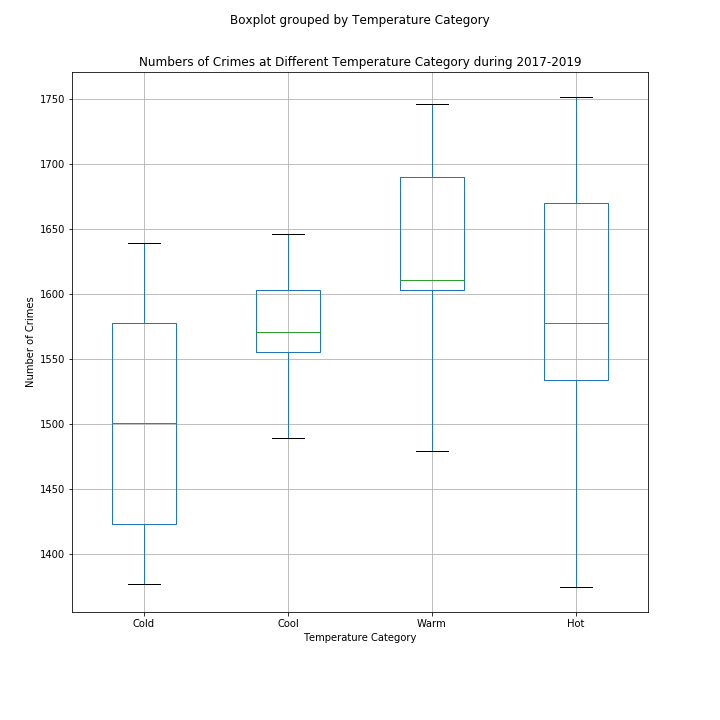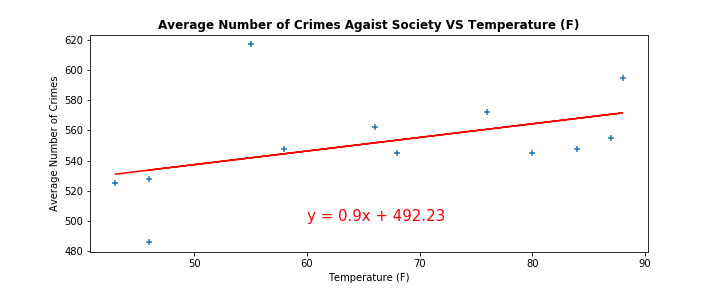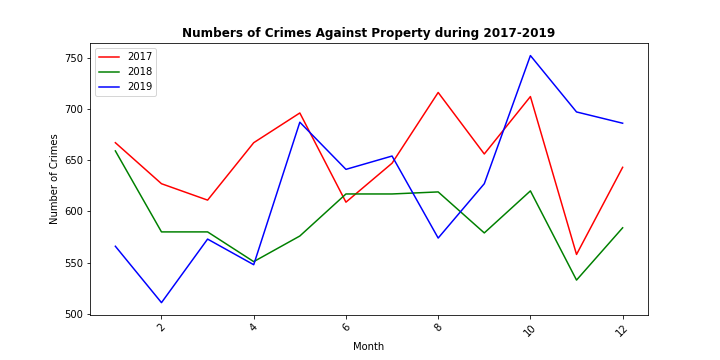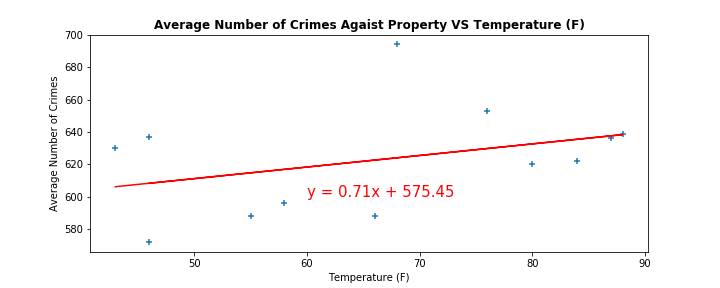Results & Analysis
Be sure to click on the image to see it in full-size!
Crime & Temperature?
Before we begin our individual analysis of each crime category, we performed a hypothesis test to determine whether temperature affects crime level in the city of Silver Spring, Maryland.
Hypothesis Testing
H0: Temperature does not affect the number of crimes in Silver Spring, Maryland.
ANOVA p-value: 0.07526130880382127
With the p-value of > 0.05, we cannot reject our null hypothesis.
Onward with the individual analysis to get some insight!
Crime Agaisnt Person
| Month | Avg # of Person Crimes | Temperature (F) | Temp Category |
|---|---|---|---|
| January | 128 | 43 | Cold |
| February | 120 | 46 | Cold |
| March | 144 | 55 | Cool |
| April | 134 | 66 | Cool |
| May | 146 | 76 | Warm |
| June | 147 | 84 | Hot |
| July | 135 | 88 | Hot |
| August | 134 | 87 | Hot |
| September | 157 | 80 | Warm |
| October | 138 | 68 | Warm |
| November | 142 | 58 | Cool |
| December | 136 | 46 | Cold |
Regression coefficients
r-value: 0.501305162690757
r2: 0.2513068661404063
The number of crimes against person seems to be lower on average from December to February during 2017-2019. The r-value of our linear regression model suggests a moderate positive correlation between temperature and the average number of crimes agaisnt person. The r2 value is very low, suggesting that the predictive power of our regression is not very reliable (we only have 12 values for the temperature data!).
| Avg # of Person Crimes | Temperature Category |
|---|---|
| Cold | 128 |
| Cool | 140 |
| Warm | 147 |
| Hot | 138 | p-value: 0.010577592770864664 |
When categorizing the temperature of each month into 4 groups, we noticed that the number of crimes against person seems to be lower when the tempearture is colder, and higher when the temperature is warmer.
We performed hypothesis testing to determine whethere any difference in temperature category is statistically significant. Our result shows that the Cold and Warm groups are significantly different from others, with the p-value of < 0.05. When the temperature is considered cold, there is less crime against person compared to when the temperature is considered warm.
Crime Agaisnt Society
| Month | Avg # of Society Crimes | Temperature (F) | Temp Category |
|---|---|---|---|
| January | 525 | 43 | Cold |
| February | 528 | 46 | Cold |
| March | 617 | 55 | Cool |
| April | 562 | 66 | Cool |
| May | 572 | 76 | Warm |
| June | 548 | 84 | Hot |
| July | 595 | 88 | Hot |
| August | 555 | 87 | Hot |
| September | 545 | 80 | Warm |
| October | 545 | 68 | Warm |
| November | 548 | 58 | Cool |
| December | 486 | 46 | Cold |
Regression coefficients
r-value: 0.4488228102691732
r2: 0.20144191501791825
The number of crimes against society seems to have a spike in March during 2017-2019. The number of crimes peaks in July of 2018, and steadily declines from March in 2019. The r-value suggests a relatively weak positive correlation between temperature and the average number of crimes agaisnt society. The r2 value is, again, very low.
| Avg # of Socierty Crimes | Temperature Category |
|---|---|
| Cold | 513 |
| Cool | 575 |
| Warm | 554 |
| Hot | 566 | p-value: 0.3226899695413077 |
There is no notable difference in the average number of crimes when we binned the data into 4 groups of temperature category.
Our statistical test shows no statistical significance in the difference in the number of crimes against society between each temperature category, with the p-value of > 0.05. The temperature does not seem to have any influence on the number of crimes agaisnt society.
Crime Agaisnt Property
| Month | Avg # of Property Crimes | Temperature (F) | Temp Category |
|---|---|---|---|
| January | 630 | 43 | Cold |
| February | 572 | 46 | Cold |
| March | 588 | 55 | Cool |
| April | 588 | 66 | Cool |
| May | 653 | 76 | Warm |
| June | 622 | 84 | Hot |
| July | 639 | 88 | Hot |
| August | 636 | 87 | Hot |
| September | 620 | 80 | Warm |
| October | 694 | 68 | Warm |
| November | 596 | 58 | Cool |
| December | 637 | 46 | Cold |
Regression coefficients
r-value: 0.501305162690757
r2: 0.2513068661404063
The number of crimes against property seems to have multiple spikes through out the year during 2017-2019, with October having the overall highest numbers. The number of crimes peaks in July of 2018, and steadily declines from March in 2019. The very small r and r2 values sugges a very weak positive correlation between temperature and the average number of crimes agaisnt property, and the low predictive power of the regression model.
| Avg # of Property Crimes | Temperature Category |
|---|---|
| Cold | 613 |
| Cool | 590 |
| Warm | 655 |
| Hot | 632 | p-value: 0.0764740094854059 |
When binning the data into 4 groups of temperature category, the Warm and Hot groups seem to have higher average number of crimes.
Our statistical test, however, shows no statistical significance in the difference in the number of crimes against propery between each temperature category, with the p-value of > 0.05. We cannot say that temperature has influence on the number of crimes agaisnt property.






